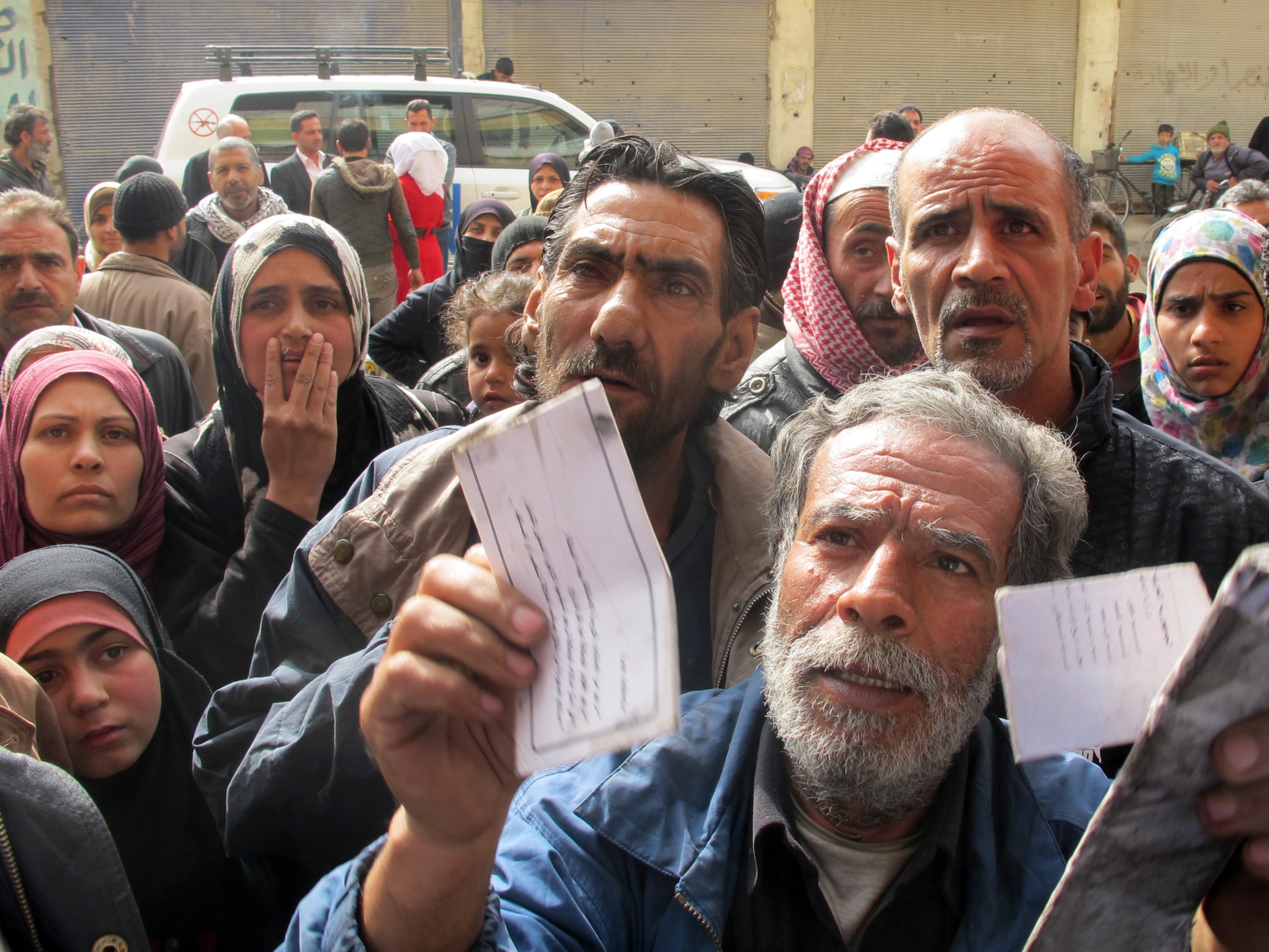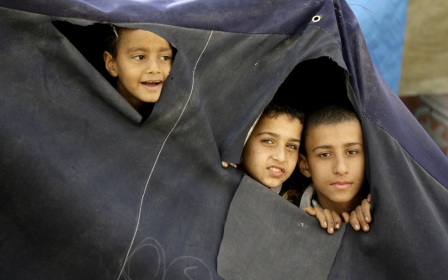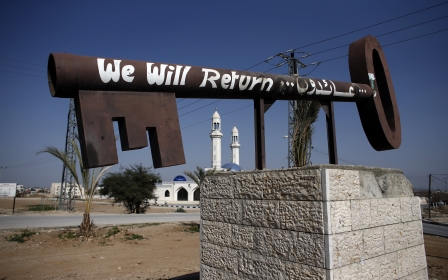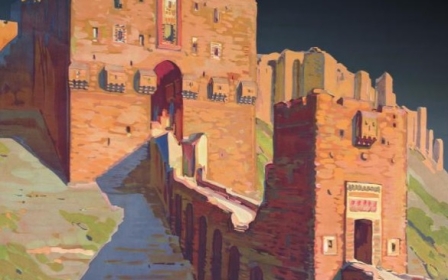Nakba without end: Memories of shattered Palestinian communities in Syria

On 15 May 2011, thousands of Palestinian refugees from Syria are marching towards Syria’s long, quiet border with Israel. Even though the protests are not as big as the organisers promised, it is both a symbolic and physical statement.
Stones are thrown, tear gas fired in reply. Some actually make it across, welcomed on the other side by villagers from the Druze town of Majdal al-Shams. One Palestinian refugee, Hassan al-Hijazi, goes further, actually taking a bus to his family’s hometown, Haifa, and proclaiming it “his town”.
Although this is a detail from the early days of the Syrian uprising that often gets missed out, it was of obvious importance to Palestinian-Syrians at the time. The bodies of three martyrs - Obaida Zaghmot, Bashar al-Shihabi, and Qays Abu al-Hayjaa’ - sometimes called the “martyrs of return,” were taken back to their camps in Syria proper and carried aloft, mourned, lionised. Some observers - including former Yarmouk resident Nidal Bitari - have claimed this was a crucial stepping-stone in the Palestinian experience of the Syrian uprising and ensuing civil war. Although many felt compelled to maintain neutrality, people also felt used, Bitari has claimed. “A feeling began to emerge that the regime had used the Palestinians for its own ends, without regard for their safety, to deflect attention from the uprising then gaining ground.”
Each year on 15 May, Palestinians mark Nakba Day, commemorating the forcible displacement of hundreds of thousands of Palestinians to neighbouring countries such as Egypt, Jordan, Lebanon and Syria, in what became known as the nakba, or catastrophe.
Reading American University of Beirut (AUB) professor Anaheed al-Hardan’s recently published book, Palestinians in Syria: Nakba Memories of Shattered Communities (Columbia University Press, 2016) around this year’s Nakba Day, one is struck by the evolution of the Nakba — not only as a historical event, site of trauma, memory remembered, but also as a term, idea, theory that has developed considerably over time.
Based on 63 interviews conducted in formal or informal Palestinian camps and communities mostly around Damascus and rural Damascus during six months of 2008, the main part of Hardan’s book gives voice to the so-called “guardians of memory”: the “generation of Palestine” who witnessed 1948 first-hand as local residents and native Palestinians, then as refugees.
Hardan charts different categories of Nakba memories; for example, heroic memories, such as how the people of peasant farming village Lubiya (where some of Yarmouk camp’s residents can be traced back to) bought rifles in preparation for the Nakba; or ambivalent memories, that combine a sense of powerlessness with agency. Nakba memories are told and recounted in different ways, too. Hardan explores engendered re-tellings and how that impacts memory.
Nakba was a term first used to describe the events of 1948 by a Damascus-born educator, historian and theorist, Constantine Zurayk. However, it would not take on a fully Palestinian, rather than Arab, connotation until years later; not until the downfall of several ancien regimes seen as responsible for their part in the catastrophe, as well as the advent of the anti-colonial, Palestine liberation movement during the late 1960s, in the form of Yasser Arafat’s Palestine Liberation Organisation (PLO).
Even then, the present state of nakba - as an event to be remembered - may not have always been the same. Hardan writes how the Oslo Accords, and the realignment of Palestine’s centrifuge away from the diaspora and back to the PLO’s seat in Ramallah and the West Bank, created a sense of “fear” amongst diaspora communities, including Syria’s Palestinians. This fear of being denied the right of return, as it became clear the PLO were willing to give up on millions of Palestinian refugees outside Palestine, sparked what became known as the Right of Return Movement (RRoM) in Syria. We are introduced to some of the characters involved: the late Ghassan al-Shehabi, for example, or grass-roots activists who ran education and awareness days commemorating lost Palestinian villages within camps in Syria.
The RoRM were building towards something and yet - and it will not be the first time - 2011 makes its presence felt.
Introductions scattered through Hardan’s ethnographic studies provide the reader street-view recollections; it might be Hardan’s journey en route to an interview, her abiding memory about where an interviewee, an old woman, was sat on a little chair in the street. They combine past and present - like, “that’s how it was then and I wonder how it is for them now” - and compounds the palpable sense of loss that understandably pervades a book about 1948 and the Syrian conflict’s impact on its descendants.
Reflecting on a picnic near Deraa, en route to an interview, Hardan remembers two “third-generation Palestinian refugee women from Khan Eshieh who learned about the Nakba through schoolbooks, and who nonetheless chose to wear the kuffiya [Palestinian scarf] that day.” She is left wondering about “those who have left the camp, and the others who have seen their families torn apart and scattered by war yet again, some even arriving at the shores of the Ionian and Baltic Seas, to tell of the minute details of the horrors of war.”
We continue to wonder as we read. Last week, pro-government forces besieged 12,000 people in Khan Eshieh, including 3,000 children - with Save the Children warning on Friday that civilians were running out of food and medicine amidst barrel bombs and sniper fire, The Guardian reported.
Palestinian-Syrian displacement, memory and loss is not history, it is happening right now. In recent weeks and months, Yarmouk camp, the beating-heart of the Palestinian-Syrian diaspora, has seen some of its fiercest clashes, this time between Islamic State and Jabhat al-Nusra, in years. Khan Eshieh is besieged. Many other Palestinian camps and communities have been badly damaged and rendered inaccessible, or simply decimated as a result of both internal and external displacement. The Palestinians have become refugees twice.
Reminding us about this is perhaps one of the most important aspects of Hardan’s book. It is an important and timely addition to the growing body of Nakba scholarship, although maybe in places more academic in tone than Dina Matar’s oral history, What It Means To Be A Palestinian: Stories of Palestinian Peoplehood (I.B. Tauris, 2011) or Diana Allan’s ethnography of Shatila camp, Refugees of the Revolution: Experiences of Palestinian Exile (Stanford University Press, 2014).
Hardan is one of the few people actively talking about Syria’s Palestinian community and its post-2011 tragedy at maybe the most crucial time of all. Just last week, UNRWA stated that more than one-fifth of Syria’s Palestinians had now fled the country. Some estimates say as many as 100,000 have taken the death boats to Europe, while hundreds have died en route.
And by looking back at the changing Nakba and its implications on those who experienced it, Hardan shows us how the Palestinians of Syria have, since 2012 especially, experienced a continuation of nakba, a second nakba or, perhaps as Hardan writes in her conclusion, a “catastrophe that the displaced post-Palestine generations now insist far exceeds the Nakba of 1948”.
Palestinians in Syria: Nakba Memories of Shattered Communities by Anaheed al-Hardan is published by (Columbia University Press, 2016).
Middle East Eye propose une couverture et une analyse indépendantes et incomparables du Moyen-Orient, de l’Afrique du Nord et d’autres régions du monde. Pour en savoir plus sur la reprise de ce contenu et les frais qui s’appliquent, veuillez remplir ce formulaire [en anglais]. Pour en savoir plus sur MEE, cliquez ici [en anglais].




